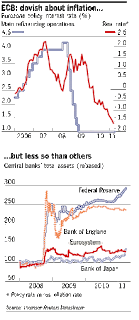I look at the following chart and ask whether or not there is some constant factor that stands behind the decline in the value of the dollar over the past fifty years.
You are right that the chart covers only the last forty years or so, but the consistency that runs from the early 1960s to the present began around fifty years ago.
The constant that runs throughout this time period is credit inflation. The foundation for this credit inflation was a “new” philosophy of the government’s program of fiscal policy, one that aimed at achieving high levels of employment. And, this new philosophy was essentially adopted by both the Republicans and Democrats in the United States government.
The consequences of this policy:
• The gross federal debt of the United States increased at a compound growth rate of about 8.0% per year for the last fifty years;
• Up until 2008, the Federal Reserve increased the monetary base at a compound rate of 6.2%;
• Total credit market debt in the United States increased at a compound rate of almost 10.0%.
• A dollar which could purchase $1.00 worth of goods and services in 1960 could only purchase $0.15 in 2011.
The credit inflation was started in the 1960s. It became such a problem that the United States floated its currency on August 15, 1971, and, with two exceptions, declined by about 35% against major currencies from early 1973 through March 2011. The two exceptions were the Volcker-led monetary tightening beginning in 1980 and the Rubin-led efforts to balance the federal budget around 1995.
One could argue that the credibility of the United States government for maintaining a stance of fiscal discipline, with these two exceptions, has been very, very low. And, that is the problem the United States finds itself in at the present: the behavior of the government, especially represented by Chairman Bernanke at the Federal Reserve, is seen as “just more of the same” economic policy that has been followed over the last fifty years. Consequently, the value of the dollar continues to decline.
In terms of the euro, Jean-Claude Trichet, the president of the European Central Bank, seems strong relative to Mr. Bernanke, and the value of the dollar continues to decline against the Euro. (http://seekingalpha.com/article/261863-the-euro-trichet-vs-bernanke)
It has been argued that Mr. Trichet and Mr. Bernanke have been working together during the recent financial crisis. That may be true, but coming out on this side of the crisis it looks to me like Mr. Trichet was the “craftier” of the two. Check out the chart below.





